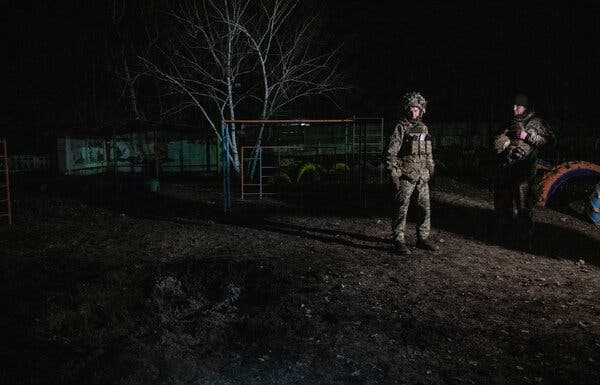
KYIV, Ukraine — Tensions between Russia and the West ratcheted up on Friday as Moscow announced plans to test nuclear-capable missiles and held war games on NATO’s doorstep in Belarus, while the United States said more Russian forces continued to take positions menacing Ukraine in a crisis that risks erupting into the biggest conflict in Europe in decades.
As President Biden prepared to speak with NATO allies on Friday, U.S. officials said that as many as 190,000 Russian troops were arrayed in and near Ukraine, a number that includes Russia-backed separatists in eastern Ukraine. The officials also repeated warnings that Moscow would try to manufacture a provocation by Ukraine to justify an invasion of its smaller neighbor.
The fears of such a “false flag” incident escalated when a leader of those separatists claimed without evidence in a video message on Friday that a Ukrainian military offensive would soon take place, and called for residents in the self-proclaimed Donetsk People’s Republic to evacuate to Russia.
The Ukrainian defense minister and foreign minister quickly denounced the claims of an imminent Ukrainian attack as fabrications designed to inflame tensions and offer a pretext for Russian military action.
The separatist leader’s message followed an intensification of shelling along the front line between Ukraine and the Russia-backed rebels, and highlighted ominous signs that a conflict that has simmered for years could become the spark for a wider war.
Consistent with Russia’s contradictory messaging throughout the crisis, however, Mr. Putin said on Friday that Russia was prepared for further diplomacy, and President Biden’s secretary of state, Antony J. Blinken, accepted an invitation to meet next week with Foreign Minister Sergey V. Lavrov. The announcement of the meeting calmed jittery markets and suggested that there was still hope for the crisis to be resolved without war.
But Mr. Putin emphasized that Russia would continue to insist on far-reaching demands for “security guarantees” in Eastern Europe that the West has rejected — such as a halt to the eastward expansion of NATO and the pullback of the alliance’s forces from the region.
“We are ready to go on the negotiating track under the condition that all questions will be considered together, without being separated from Russia’s main proposals,” Mr. Putin said in a news conference alongside his close ally President Aleksandr G. Lukashenko of Belarus, who was visiting Moscow.
The Biden administration has said it believes Russia is poised to invade Ukraine within days. Although Moscow insists that it has no such plans, it has vowed to mount “a tough response” if the United States and its NATO partners do not roll back their presence in Eastern Europe.

Russian or Russian-
backed military
positions as of Feb. 13
Stanytsia Luhanska
Approximate line
separating Ukrainian
and Russian-backed
separatist forces.
Rostov-on-Don
SEA OF
AZOV
Sevastopol

Russian or Russian-backed
military positions as of Feb. 13
Stanytsia Luhanska
Kryvyi Rih
Approximate line
separating Ukrainian
and Russian-backed
separatist forces.
Sevastopol
In a demonstration of strength, Russia will conduct major drills this weekend that will include the launch of ballistic and cruise missiles, the country’s defense ministry said, according to the Interfax news agency.
Russia’s drills will test its strategic nuclear forces, which include the land-based launchers, bombers and warships used to deliver nuclear weapons. They will involve the Black Sea Fleet, which has been engaged in large-scale exercises in the region bordering Ukraine. Mr. Putin will preside over them from a “situation center,” the Kremlin said.
The Defense Ministry said the drills were planned in advance, and Mr. Peskov denied that they were intended to raise tensions. But they will come at a critical juncture in the standoff over Ukraine.
An uneasy calm settled over eastern Ukraine on Friday after a night punctuated by explosions and bursts of gunfire in as many as 30 villages and towns along a 250-mile stretch of land separating Ukrainian and Russia-backed forces. Although periodic exchanges of gunfire are not uncommon in the grinding, eight-year trench war, that violence was of a heightened scale.
As the events play out, officials in Russia, the United States and in Ukraine are trying to shape the narrative.
U.S. officials said they were “watching closely” out of concern that Russia could use violence in eastern Ukraine as a pretext to invade Ukraine. Mr. Blinken told the United Nations Security Council on Thursday that Russia planned to “manufacture a pretext for its attack,” possibly with a “so-called terrorist bombing” or “a fake, even a real attack” with chemical weapons.
On Friday, Mr. Lavrov said blamed Ukrainian forces for “a sharp increase in shelling in eastern Ukraine,” and said that a monitoring mission led by the Organization for Security and Cooperation in Europe had been obscuring evidence of Ukrainian aggression.
“The Kyiv regime has been violating its responsibilities for several years,” he said.




